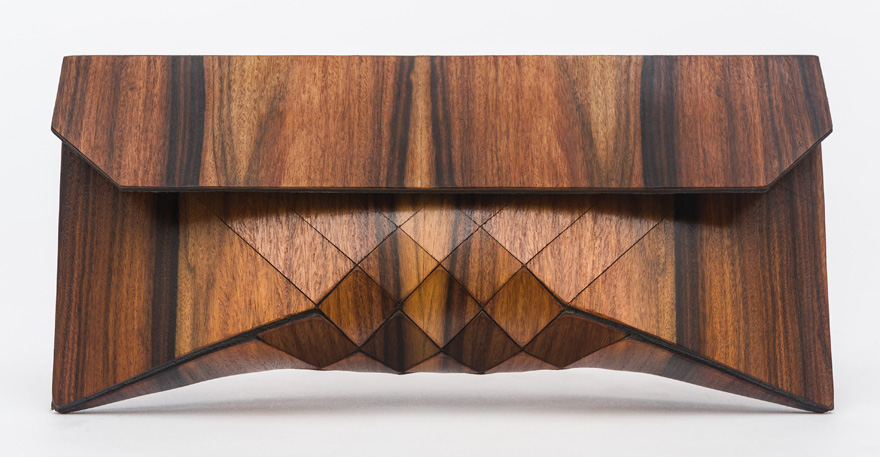In the Details: The 'Wood Skin' in Tesler + Mendelovitch's Geometric Clutches

These days, lovers of a rustic aesthetic can choose from all sorts of personal accessories made of wood—there are wooden iPhone cases, wooden eyeglasses frames and even wooden engagement rings. But a wooden purse? The idea sounds clunky at best, summoning images of a glorified briefcase or perhaps the enigmatic Log Lady from Twin Peaks.
The Tel Aviv design studio Tesler + Mendelovitch has managed to pull it off, however, with a line of "wood skin" clutches that are remarkably elegant and eminently functional, thanks to a set of diagonally-oriented crosshatches that allow the wood veneer to arch and fold like a textile.
The transformation from raw lumber to limber handbags did not come easy. It took the designers, Orli Tesler and Itamar Mendelovitch, years before finding a form that felt right. "It took such a long time to get the simple shape," Tesler says. "In the beginning, we interfered terribly with the wood." She had her partner experimented with weaving it, sanding it and breaking it up into small fibers. "Nothing seemed to showcase the wood in a new way."



A breakthrough came when they started slicing. Cutting into the wood helped uncover the material's weak spots, and bending it gave them insight into how it behaved. "If you go too much against the grain, the wood will not budge; it will crack or splinter," Tesler says. "And if you go too much with the grain, all you have are straight lines. The point of going diagonally is to cross over the soft and hard points where wood can bend without breaking." Once Tesler and Mendelovich realized how they were able to manipulate the material with incisions, they started paring down the number of diagonal slashes, only leaving those cuts that were necessary for the construction to perform.
Today the purses are made from a range of veneers, including ebony, rosewood, walnut and birch—all of which have their quirks. "There are a lot of factors that come into play when working with an organic material," Tesler says. "The easiest wood to work with is American Walnut. It's very compliant to our technique. The others sometimes demand a little more time because some of them are drier, or a little more moist, or stiffer. In a raw form, they're very sensitive to weather conditions too."
The varieties, typically, are picked for their bold vertical grain. (Woods that are too wavy or have swirled or overly colorful grain won't make the cut.) When the designers can find one, they'll use a single long piece of veneer with a compelling pattern to complete one clutch. Other times, they'll pick sections of veneer piecemeal and puzzle them together into a natural-looking pattern.
 Above: Orli Tesler and Itamar Mendelovitch. Below: early "wood skin" experiments
Above: Orli Tesler and Itamar Mendelovitch. Below: early "wood skin" experiments
Once Tesler and Mendelovitch have chosen the veneer, they work it by hand, scrubbing it of debris and treating the wood to soften it up. Then they layer it, which adds strength. Next, they get down to cutting. "It's all done very slowly and lightly," Tesler says. "The lines are not done in one shot, in order not to splinter the wood or create cracks. We don't want to shock it too much in the beginning."
Once the incisions are complete, the shape is lined with a high-quality leather that boosts the product aesthetically while also providing a soft barrier for hard items, like keys, that could damage its interior. In addition, the sides of the clutch are strengthened with a pair of studs secured via a drill—the only element of production not carried out by hand.
The final product is quite strong. "Unless someone rams it with a car or drops it from the roof or sits on it, it will hold for what we believe will be a very long time," Tesler says. Even so, she recommends the same kind of care that they practice in the clutch's development: a gentle touch.
-
oFavorite This
-
QComment
K
{Welcome
Create a Core77 Account
Already have an account? Sign In
By creating a Core77 account you confirm that you accept the Terms of Use
K
Reset Password
Please enter your email and we will send an email to reset your password.

